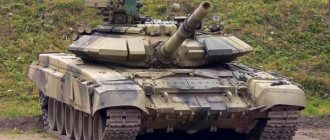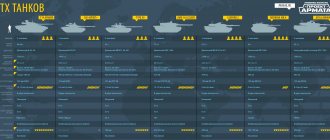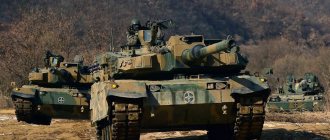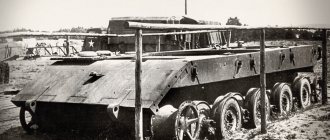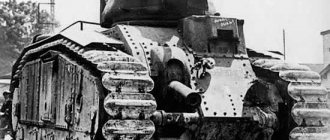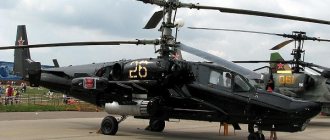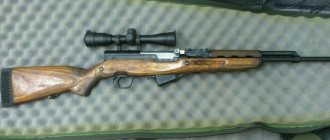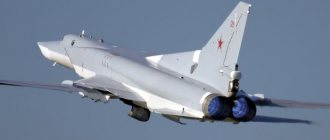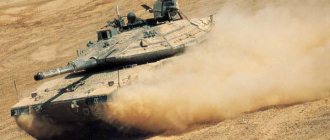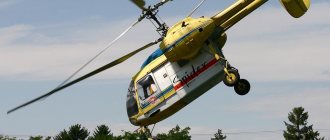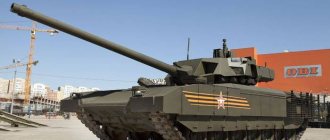Author: Ivan Rzhanov
15 January 2022 21:19
Tags: Russia armata armies war soldiers tanks equipment
14071
11
1
Tank troops are considered one of the most powerful components of the modern army. Developers all over the world are paying special attention to improving tanks and other heavy armored vehicles so that they can carry out a large number of assigned combat missions. Russia was no exception, where specialists decided to create powerful combat vehicles based on the special Armata tracked platform, which will allow unifying armored units and units.
0
See all photos in the gallery
Of the entire Armata family, the most anticipated new product in military engineering was the main tank - a new combat vehicle, on the creation of which Uralvagonzavod specialists, engineers and designers worked hard.
Technical characteristics of the Armata T-14 tank
0
1. Combat weight 48 tons 2. Crew - 3 people 3. Reservation - combined multi-layer armor - Afghanit active protection complex - Malachite dynamic protection 4. Armament - 125 mm 2A82-1M smoothbore gun (152 mm 2A83) - Gun ammunition 45 rounds (32 pieces in the automatic loader) - Machine guns - 1 × 12.7 mm Kord; 1 × 7.62 mm PKTM 5. Engine - multi-fuel A-85-3A (12N360) - Engine power 1500 hp. 6. Speed on the highway - 80 - 90 km/h 7. Speed on rough terrain - about 70 km/h 8. Cruising range on the highway - over 500 km 9. Specific power - 31 hp. s./t 10. Suspension type - active.
Armament
Performance characteristics of the "Almata" and its weapons
Despite the concept of using the T-14 for reconnaissance and coordination of a tank unit, the Armata's own weapons correspond to the parameters of the main battle tank. The following aspects are highlighted in this issue:
- 125 mm gun 2A82-1M;
- machine guns "Kord" and PKTM.
The guns and machine guns are guided by a fire control system (FCS). The ballistic computer makes the necessary calculations using the following parameters:
- determining the tank’s own position using the GLONASS receiver and inertial navigation system;
- gyroscopic calculation of the tank’s position based on its angular orientation in space;
- calculation of wind direction and speed;
- determination of air temperature and humidity;
- taking into account barrel curvature during heating.
All sensors are located on the roof of the tank. Taken together, the system allows you to automatically calculate the necessary parameters. Many experts agree that this operating principle makes weapon control more similar to a computer game than to real control of a combat vehicle.
Smoothbore 125 mm gun 2A82-1M
Armata tanks are equipped with 2A82-1M smoothbore guns with a caliber of 125 mm. Their range is 7 km, rate of fire is 10-12 rounds per minute. In terms of technical characteristics, such guns are superior to the best NATO tank guns by 17% in muzzle energy and 20% in accuracy.
The supply of ammunition is automatic. It is possible to load the gun with projectiles a meter long, which allows the use of high-power sub-caliber armor-piercing ammunition. The gun's total ammunition capacity is 45 rounds, but its staffing has not yet been approved.
If necessary, 2A83 guns of 152 mm caliber can be installed on Armata tanks. This weapon has the ability to penetrate armor equivalent to up to 1000 mm, which significantly exceeds the protection of modern NATO tanks. Given the power of such a gun, there is no need for armor-piercing shells - the kinetic energy of the fired ammunition is enough to tear off the entire turret of any tank.
Taking into account this factor, the installation of these guns is still considered inappropriate. This makes the T-14 upgradeable if necessary to enhance the firepower of a tank unit. The probable reduction in the ammunition capacity of the new gun is also taken into account - to increase it it is planned to use a turret niche.
Reflex-M missiles
In addition to standard tank shells, the T-14 can hit targets with Reflex-M solid-fuel anti-tank guided missiles. They are capable of hitting almost any highly protected surface, ground and low-flying targets.
The charging of these missiles is carried out according to a tandem scheme. The leading part is designed to overcome the dynamic protection of the target. The main charge is aimed at penetrating armor and directly defeating vehicles or pillboxes. The projectile's flight path is a helical line.
If necessary, the tank can use a variant of the rocket with a thermobaric warhead. Such shells are designed to destroy enemy personnel, engineering structures and lightly armored vehicles.
PKTM machine gun
The Kalashnikov tank modernized machine gun (PKTM) on the T-14 is paired with a gun. Caliber - 7.62 mm. There is no information yet about the ammunition load. Designed primarily to engage infantry and lightly armored targets.
Machine gun "Kord" for destroying enemy shells and missiles
The Kord machine gun serves as an anti-aircraft installation for the tank and its air defense. Integrated with active tank protection. It has its own robotic turret, thermal imagers and AFAR radar, thanks to which it is capable of hitting even high-speed targets at a distance of 1.5 kilometers. Designed primarily to destroy shells and missiles.
Multi-level protection of the Armata tank
0
The main feature of the T-14 tank is the uninhabited turret of the tank - the crew is located in an isolated armored capsule; among other things, a multi-layer combined armor barrier is installed in the front projection of the combat vehicle, protecting tank crews during frontal hits from anti-tank shells and missiles. This approach to tank design allows the combat vehicle to withstand hits from most modern and future ATGMs and anti-tank shells, while preserving the lives of tank crews. The manned armored capsule also houses control computers, which makes the tank more survivable in modern combat conditions.
On the way to a breakthrough
Successful decisions by Soviet designers in the mid-60s made it possible to create tanks with a dense layout.
Combat vehicles have become compact, not too heavy, but at the same time well protected. On the other hand, if an enemy shell did penetrate the armor, this was almost guaranteed to be followed by the destruction of the tank units or the defeat of the tank crews. Of particular concern was the stowage of ammunition located directly in the fighting compartment. By the end of the 80s, the USSR army had three types of main tanks: T-64, T-72 and T-80.
This went against the principle of unification of armored forces. The T-90, which was supposed to replace them, was not truly innovative. In the 80s, work on promising tanks went on at all the main tank factories of the USSR. The designers sought to increase firepower (including by increasing the caliber of the gun), enhance armor protection and automate the vehicles as much as possible. In addition, it was necessary to work out a version of a new layout, since the classic one no longer fully ensured the survivability of the tank and its crew on the battlefield.
Soviet designers were faced with a difficult task: they had to develop an innovative solution to separate and protect the crew, fighting compartment and ammunition stowage. They worked on this in Kharkov, Nizhny Tagil and Leningrad. The project of Nizhny Tagil designers “Uralvagon, although it was not embodied in metal, became the basis for the development work program “Improvement-88”. In 2000, within its framework, the “Object 195” was created, the predecessor of the T-14 tank, built on the basis of the heavy unified tracked platform “Armata”.
What is the logic behind creating a unified platform? The industry's task of producing spare parts is simplified. It’s easier for repairmen to work, easier to train personnel. A single platform allows you to obtain a large number of machines, which reduces the cost of each individual unit. Equipment at the same base has approximately the same speed, which is very important when a unit is moving on the march. Example: a tank bridge-layer, which is close in protection to the main tank, should not lag behind; it needs to appear on the battlefield along with combat vehicles.
Location of components and modules of Almata
0
The engine, transmission, as well as the automatic loader with ammunition are isolated from each other, which dramatically increases the survivability of the Almata even if the armor of the turret or engine/transmission compartments of the tank is penetrated. That is, if there is no direct hit in the compartment with ammunition and an automatic loader, then there will be no detonation of the ammunition. Even with multiple penetrations of the tank, the armored capsule will protect the crew and fire control systems, allowing the robotic uninhabited turret to fire. Another original solution is that the crew is positioned in a row, which reduces the area of the side projection of the manned armored capsule, sharply reducing the likelihood of being hit.
0
The T-14 tank uses a new mine-resistant V-shaped armor; remote mine detectors are installed on the tank, which are connected to an anti-tank mine destruction system, which allows the tank to overcome minefields.
Advantages and disadvantages
The T-14 integrates many innovative developments and technologies.
Taking into account the design and performance characteristics of the T-14, the following advantages of the new tank are highlighted:
- crew protection, improved protection of the vehicle itself and its components;
- high firepower, firing accuracy;
- high speed and smooth ride on rough terrain, taking into account how much the tank weighs;
- invisibility of the machine for various detection methods;
- high range of detection and destruction of targets;
- a resource for further modernization of the tank, including increasing firepower.
Many characteristics and indicators remain unconfirmed or classified. However, the available data confirms the exceptional position of the Armata among modern tanks. At the same time, attention is also paid to the shortcomings of the T-14.
The main questions are raised by the decision to transfer the crew to an armored capsule. This increases its security, but does not allow visibility from the tower. Accordingly, the role of optical technology increases, which creates special requirements for its protection from damage and blinding.
Another disadvantage is the cost of a new tank. Even in mass production, its assembly costs about 250-350 million rubles, which casts doubt on the mass production of such tanks for the army, as well as the likelihood of their production for export.
Despite the inconsistency and inaccuracy of a number of aspects, the project is assessed positively. Western military analysts point to the design understanding of Russian developers of the modern concept of combat operations. The creation of the Armata demonstrates a transition from the quantity of equipment used to the quality combat capability of small tactical groups.
Turret of the T-14 Armata tank
0
The turret of the Armata T-14 tank, as we wrote above, is uninhabited; its armor consists of anti-fragmentation casings to protect instruments and weapons. The steel casing protects the turret instruments, as well as dynamic protection modules from light fragmentation damage; an additional function of the casing is to reduce the radio signature of the tank against ATGMs/ATGMs with radar guidance of the JAGM type, due to the geometry of the surface.
Detection complex
The ability to detect the enemy for the Armata tank is one of the main functions. A four-section radar with cameras allows you to detect enemy forces within a radius of 10 km, as well as at boundaries of up to 100 km. The phased array radar provides tracking of 40 ground and 25 air targets. Intervention by crew members in the operation of the tracking system will only be required when the target is thoroughly camouflaged. The tank driver is guided by the indicators of the optical periscopes. Infrared headlight illumination provides a clear picture even at night.
For the first time, the developers used the Pterodactyl unmanned aerial vehicle for short-range reconnaissance. It is capable of flying within a radius of up to 100 meters, as it is connected to the machine by a shielded cable through which a video image is transmitted. The observation horizon of the aircraft is 10 km. This makes it possible to fight from cover or from the suspension of a masking cloud. It is noteworthy that the picture received by Pterodactyl can be transmitted not only to the corresponding tank, but also to all vehicles in the tactical group.
The detection system operates with small errors, but they do not interfere with targeted fire. For example, the error in the position of a target located at a distance of 10 km does not exceed 17 meters. The tank can fix the location of the explosion, and therefore serves as a fire spotter. The system tracks the launch site of enemy ammunition and transmits data to the accompanying T-15 infantry fighting vehicle, a unit with MANPADS or the Pantsir-S1 air defense system.
Active protection complex "Afganit"
0
But armor cannot 100% protect a tank from modern anti-tank weapons, so the T-14 is equipped with the Afghanit active protection complex, which has the ability to intercept modern ATGMs, cumulative grenades from RPGs, as well as sub-caliber armor-piercing shells while approaching the tank. Defense Update experts, when analyzing the Afghanit system on the T-14, indicate that it consists of damaging and camouflage elements. The striking elements are located in shotgun pedestals under the turret, which operate similarly to the Drozd KAZ, but more efficiently - the reaction time allows you to intercept even sub-caliber shells. The Afghanit developers also received patent RU 2263268 for an active protection system based on the “shock core” principle, which allows them to shoot down promising ammunition at speeds of up to 3000 m/s. The camouflage elements of the Afghanit active protection complex are located in small mortars on the roof of the tank turret. Defense Update experts report that, presumably, the camouflage elements operate simultaneously as: a smoke screen, a multispectral curtain (including the IR range) and a curtain opaque to millimeter-wave radars (by releasing a cloud of miniature dipoles). According to Defense Update, this completely blocks anti-tank systems built on the principle of laser (ATGM Hellfire, TOW, Fagot, Skif, Stugna-P), IR guidance (ATGM Javelin, Spike) and with their own MW radar (ATGM JAGM, Brimstone) , making Armata protected from these anti-tank missiles, as well as from gliding homing charges (“roofbreakers”).
0
To counteract guidance radars and AWACS aircraft, the T-14 tank uses modern elements of stealth technology with characteristic flat edges (see, for example, the casing on the turret of the Armata tank). Defense Update experts indicate that the combined destructive and camouflage KAZ "Afganit" is triggered by an AFAR radar, which is divided into 4 separate matrices directed in different directions, the rear matrices are turned upward to control the upper hemisphere, so the AFAR radar has circular coverage. The tank's optical surveillance equipment is also integrated with a system for proactive delivery of curtains. Previously, the developers of the T-14 also reported that the machine gun mount, based on data from the AFAR radar, is capable of protecting the tank not only by shooting down incoming anti-tank missiles, but also having a significant probability of hitting anti-tank shells in order to change the flight path of sub-caliber shells or damage cumulative ammunition.
Participation in exercises
In 2020, the Armata is undergoing state tests.
The Armata tank has not yet taken part in large-scale exercises or combat operations. From December 31, 2022, it is undergoing state tests. Taking into account its cost, the initial purchase orders of the Russian Ministry of Defense were reduced. So far we are talking about assembling 132 vehicles, which include the T-15 infantry fighting vehicle.
Despite the absence of exercises using the T-14, the performance characteristics and design features of the Armata today form new requirements for next-generation tanks:
- on rough terrain, good speed and accuracy of mobile shooting must be maintained;
- AFAR radar for detecting threats is becoming a mandatory attribute of modern technology;
- the tank must be equipped with stealth technologies to reduce visibility, including creating jamming and dynamically changing signatures;
- previous smoke screens are not capable of hiding a vehicle in the infrared and radar range, which requires the creation of new opaque multispectral screens;
- the active protection of the tank must be able to defeat guided missiles and armor-piercing sub-caliber projectiles;
- the anti-aircraft machine gun is also becoming obsolete, instead the emphasis is shifting in favor of robotic installations capable of shooting down objects at high speed;
- the tank's armament should include electromagnetic means of combat, at least against guided missiles;
- the frontal armor of the tank must correspond to an equivalent thickness of 1000 mm;
- the vehicle's reactive armor must repel attacks from hand-held grenade launchers and heavy anti-tank missiles with tandem warheads;
- To significantly damage a tank, it is no longer enough to break through its turret; a significant impact force is required;
- ammunition designed to damage the crew with shrapnel becomes ineffective in the presence of an armored capsule.
In the context of such descriptions and requirements put forward by the development and testing of the T-14, it is expected that other states will actively begin to develop new generation tanks. Time will tell whether Armata will remain competitive after the appearance of analogues in other countries.
New steel for armor of the Armata tank
0
For combined multilayer armor, specialists from the Research Institute of Steel have developed a new armor steel grade 44S-SV-Sh of high resistance electroslag remelting, as well as new materials and filler designs. This made it possible to reduce the total weight of the tank's armor protection by 15% while maintaining armor resistance. Dynamic protection of the T-14 was created according to the principle of design and modification of the configuration to suit the scenario of combat use of the tank. On the march, dynamic protection can be removed, and additional modules can be installed for an urban combat scenario.
Other modern combat vehicles in service with Russia
Today the Russian Army uses T-80U , T-80BV and BVM , T-72B3 , T-72 , T-72B , T-72BA , which have undergone deep modernization. Thanks to this, they can easily compete with the most modern cars from around the world.
how many T-90 and T-14 Armata tanks are in Russia’s arsenal, since major rearmament has been underway in recent years. However, the production and development of new projects does not stop, and perhaps very soon we will see a new generation MBT, which will operate on completely different physical principles.
Chassis and engine of Almaty
0
The new Armata medium tank is equipped with a 12-cylinder four-stroke X-shaped turbocharged diesel engine A-85-3A (12N360) with a power of 1,500 horsepower. The 12N360 multi-fuel engine, with direct injection, was developed by the Chelyabinsk Transdiesel design bureau and is produced at ChTZ (Chelyabinsk Tractor Plant). The tank has a 7-roller active suspension on vane shock absorbers with a differential steering mechanism with hydrostatic transmission. The new active suspension eliminates the swaying of the tank while moving, which makes it possible to reduce the time of target acquisition by optical-electronic guidance means by 2.2 times, reducing the time of hitting a “tank” type target by 1.45 times! The T-14 Armata is equipped with a tank information and control system (TIUS), which monitors all components and assemblies, controls on-board systems, and diagnoses faults, which allows the driver to control the engine and chassis without leaving the armored capsule for inspection and diagnostics - the need for repairs is determined electronics. In the T-14, the design of additional fuel tanks was changed; for the first time for Soviet and Russian tanks, they became non-removable and recessed behind the armor and anti-cumulative shield. In this case, the tanks participate in additional protection of the engine, taking on shock deformations. The exhaust of Almaty engines is produced through pipes running through additional fuel tanks, which, taking into account the high heat capacity of hundreds of liters of fuel, reduces the visibility of the tank in the infrared range. Although the new tank is being created according to all the standards of Russian tank building and is quite often compared to the Black Eagle, the model is an absolute novelty that has no analogues. An important distinguishing feature is the development of a high level of safety for the crew, which will be housed in a special armored capsule.
History of development and generation of tanks
Tank "Armata"
The history of the development of the platform and the Armata tank is associated with the rivalry between the USA and the USSR in the creation of vehicles with an uninhabited turret. The first drawings of such projects began to be developed in the 1980s. Later they were continued by several developments - objects 195, 640 and 299.
Despite the economic difficulties of the 90s, the Russian designer managed to create the first tank focused on conducting network-centric warfare. The development was based on the creation of the Armata universal combat platform, work on which has been carried out since 2009.
For its design, the developments of previous experimental tanks and combat vehicles were used. The peculiarity of the new platform was its wide range of applications. The modular system made it possible to supplement it with the necessary weapons in accordance with the specifics of the order.
Taking into account the versatility of the platform, the T-14 Armata turret is made uninhabited with automated weapons control. The crew itself is completely moved to the control compartment in the bow of the hull.
This arrangement provided the crew with additional protection. This aspect solves two problems at the same time - it increases the efficiency of the crew, who feel their “invulnerability” and protects trained professionals, whose value has become equal to the cost of the tank itself.
Also, when developing the Armata tank, the increased importance of infantry formations armed with modern anti-tank missile systems was taken into account. In this context, the concept of a single tank is considered obsolete. In the new concept of combat, the emphasis is placed on tactical units of several combat vehicles.
Taking this factor into account, the universal platform “Armata” was created. The T-14 developed on its basis performs the function of reconnaissance and coordination of actions with other tactical level vehicles. This does not reduce the combat characteristics of the tank, but it changes the conditions for its use in battle.
The name of the platform and tank has nothing to do with the armada. The name of the first Russian cannons of the 14th century is based on the Latin root arma, translated as “weapon”.
Detection and targeting system
The basis of the reconnaissance and guidance system in the T-14 tank is a radar complex, including a radar with an antenna in the form of an active phased array (APA). It can be considered an integral part of the Afghanit KAZ. Similar radars are used on the latest generation of combat aircraft. The antenna is located on the tower and provides all-round visibility. It consists of four panels. The tank's radar has the ability to simultaneously hold more than 20 air and 40 ground targets. The detection range is 100 km. Radar protection is provided by a screen that is not pierced by bullets and shrapnel.
The tank's radar is capable of determining the flight path of a projectile, and from it the location of a gun or launcher. The resulting coordinates are transmitted to the computer, which further makes it possible to ensure high-precision suppression of enemy firing points. The detection of air targets is quite effective. The radar determines the coordinates of the aircraft and its flight trajectory, the signal is transmitted to the Osa, Sosna or Strela air defense systems, and even Pantsir S1.
In addition to the specified radar, the tank is equipped with two radars for detecting close targets. Their main difference is an ultra-fast response to detected objects. Additional radars are needed to combat ATGMs and BOPS.
The guidance system includes a panoramic sight in the machine gun turret. It features an infrared (IR) system with high precision and sensitivity, cryogenically cooled. A system operating in the visible light range is combined with an IR camera. In addition, a laser-based rangefinder is installed.
The entire machine gun mount, together with guidance devices, has the ability to make a full rotation. Rotation of the weapon and sight can be carried out independently or together.
The sight and rangefinder are combined with a radar, and information about targets is sent to the tank commander’s computer monitor. The laser sight allows you to hold the target even after interference with the tank's radar from enemy electronic warfare. The received information about ground and air targets is sent to the command device of the unified tactical level control system (ESU T3), which is capable of selecting the necessary weapons to suppress the target. The gunner has his own touch screen, on which he can clarify the gun's pointing coordinates.
In addition to electronic surveillance systems, the tank is equipped with optical periscopes. They can be used by the commander and driver. At night, night vision devices are used. Optical devices help to navigate when the enemy is suppressing electronics.
Additionally, the T-14 tank is equipped with high-resolution cameras. A total of six cameras are placed on the tower, providing all-round visibility. The devices have independent power supply and devices for automatic cleaning of dirt. They operate independently of the tank's electronics and allow you to detect targets when the radar is turned off. If necessary, the cameras are connected to the KAZ. The devices have a SWIR system, which makes it possible to operate in the short-wave infrared range. This provides control in smoky and dense fog conditions.
Armatosracherea
| 1 | 3 | yes | Show | Hide |
|
Stealth means
Troops are increasingly using camouflage methods that can make military equipment invisible to enemy radars and visual observation, i.e. stealth technologies. The T-14 tank uses the following stealth systems:
special heat-insulating coating on the inside of the body; masking exhaust gas distribution system; a special shape of the tower and platform, including an arrangement of flat faces that reduces radio signature due to diffuse reflection; special painting of the hull on the outside, and the paint has the ability to absorb radio waves and protect against heating under the influence of sunlight, which distorts the magnetic and thermal fields induced on the tank.
A special system installed on the T-14 tank can seriously disrupt the ability of enemy radars to identify it. It distorts the resulting fields. The homing devices of ATGMs are programmed to a certain image of a tank, and therefore, if the signal is distorted, the missile loses its target. Distorted signals are transmitted in the radio and infrared ranges, and are also provided by thermal sources. The camouflage system is combined with the Afghanit KAZ. To trigger it, signals from APR antennas are used. Jamming is provided in all directions, including upwards, to make it difficult for air reconnaissance aircraft to observe.
Okay, so what’s the end result? No. 2
The cast-iron reality of the vastness of plans was shattered.
After some time, the stormy fights subsided, and now the shit occasionally boils up in a sluggish mode. And the fate of the tank itself continues to remain quite vague: plans for thousands of Armatas were never destined to come true, on the other hand, there is some movement regarding the project - state tests are being carried out, the tank is being purchased in small quantities, the media still periodically threaten that It will soon be time to produce hundreds of T-14s. In general, quite routine and trivial matters, rather dull for a bored Internet hamster, thirsty for scandals, intrigues, revelations in the style of OH-GOD-ARMATA-EVERYTHING!!! or at least the HORDES OF DUMB ARMATS WILL SOON OVERCOME EVERYONE!!!
The reality is still very far from the Internet hysterics: even if the tank really does not expect mass production in the next decade, and Uralvagonzavod really has problems with personnel and finances, the work being carried out now still continues to provide a foundation for the future, and the tank itself It’s no longer a paper project, but a very real machine, albeit in the amount of several dozen pieces. At the same time, the closest competitors still don’t even have a project[2] - it would be useful to remind any armament hater of this fact. After which, with a 99% probability, the srach will be led away in the direction of “tanks are not needed, Armata is not needed, Vova and the others are sawing again” - another reminder that breeding srach and demonstrating one’s shitty beliefs is much more important for politically motivated rednecks than any attempts to understand to the heart of the matter.
That's how we live.
Tanchega PR in the media
Fuck you!
Superman bends Armata, sent personally by the bloody Puten. Not a joke. Stories about the T-14 on Rasseyansky TV consist, as you might guess, of 146% laudatory odes to the new tankoidol. Newspapers are not far behind, although they are often a little more objective. And, as usual, the practice is to take any more or less positive statements about the tank out of the context of Western articles, proudly laying the blame on unimportant details (fact-checking in Russia, ara, that’s what it is).
From time to time, the developers of the tank themselves throw a good splash of PR onto the sizzling frying pan - promising the robotization of the tank, for example.
The car has aroused some interest in the West, so foreign media are not lagging behind, although, of course, there are much more critical and skeptical articles about the tank. However, evil tongues claim that all the attention to the subject is needed only to intimidate the Western public and extort money from taxpayers and politicians to develop a response to Armata.
A month after the Victory Parade, Chinese friends also decided to publicly promote the tank, saying that the T-14 is inferior to the Chinese VT-4 tank in maneuverability, firepower and finally whitewash us! nase lutse, desevle! “it was the competition from the VT-4 that forced Russia to begin developing the Armata,” that’s right! To which we received a stern and no less delivering answer about rusty, shitty Chinese tanks all the way from Mordor.
It is also worth considering the option that all this television and Internet bullshit is needed only to envelop Ramata with an information veil in order to hide its real shortcomings and weaknesses. Well, in the end, why shouldn’t an honest Russian citizen be proud of a brand new tank from the bottom of his heart?
Notes
- In fact, Armata is a unified tracked platform, but no one gives a fuck and the tank is often called simply Armata
- In the summer of 2022, the Franco-German concern KNDS showed at the exhibition a certain EMBT (Euro Main Battle Tank) - a vehicle obtained by literally crossing a Leclerc with a Leopard-2 (a Leclerc turret with an automatic loader + a Leopard chassis). There is very little information about this concept and there has been no further news about it since the exhibition.
| [ + ] Armata is the key to victory! | |||||||||||||||||||||||
| |||||||||||||||||||||||
| [ + ] Armata is an official discipline of the Special Olympics. For more information, visit the Special Olympics portal | |||||||||||||||||
| |||||||||||||||||
Content
- 1 A little history
- 2 Advantages/disadvantages of the machine
- 3 Tancheg PR in the media
- 4 Armatosrach 4.1 Thin hatches
- 4.2 Cardboard tank
- 4.3 Niezdit!
- 4.4 Too big
- 4.5 Armata vs Oplot
- 4.6 The Russians stole the tank idea
- 4.7 Bad engine
- 4.8 Weapon. 125 vs 152
- 4.9 Cost
- 4.10 Armata - Khuita
- 4.11 Armata not needed
